NVIDIA GeForce GTX 670 Review Feat. EVGA: Bringing GK104 Down To $400
by Ryan Smith on May 10, 2012 9:00 AM ESTOC: Power, Temperature, & Noise
Our final task is our look at GTX 670’s overclocking capabilities. Based on what we’ve seen thus far with GTX 670, it looks like NVIDIA is binning chips based on functional units rather than clockspeeds. As a result GTX 670 could have quite a bit of overclocking potential, albeit one still limited by the lack of voltage control.
| GeForce 600 Series Overclocking | |||||
| GTX 670 | EVGA GTX 670SC | GTX 680 | |||
| Shipping Core Clock | 915MHz | 967MHz | 1006MHz | ||
| Shipping Max Boost Clock | 1084MHz | 1188MHz | 1110MHz | ||
| Shipping Memory Clock | 6GHz | 6GHz | 6GHz | ||
| Shipping Max Boost Voltage | 1.175v | 1.162v | 1.175v | ||
| Overclock Core Clock | 1065MHz | 1042MHz | 1106MHz | ||
| Overclock Max Boost Clock | 1234MHz | 1263MHz | 1210MHz | ||
| Overclock Memory Clock | 6.9GHz | 6.6GHz | 6.5GHz | ||
| Overclock Max Boost Voltage | 1.175v | 1.162v | 1.175v | ||
Because of the wider gap between base clock and boost clock on the GTX 670 we see that it doesn’t overclock quite as far as GTX 680 from a base clock perspective, but from the perspective of the maximum boost clock we’ve slightly exceeded the GTX 680. Depending on where a game lands against NVIDIA’s power targets this can either mean that an overclocked GTX 670 is faster or slower than an overclocked GTX 680, but at the same time it means that overclocking potential is clearly there.
We’re also seeing another strong memory overclock out of a GK104 card here. GTX 680 only hit 6.5GHz while GTX 690 could hit 7GHz. GTX 670 is only a bit weaker at 6.9GHz, indicating that even with the relatively small PCB that NVIDIA can still exceed the high memory clocks they were shooting for. At the same time however this is a luck of the draw matter.
The EVGA card meanwhile fares both worse and better. Its gap between the base clock and and maximum boost clock is even larger than the reference GTX 670, leading to it having an even lower overclocked base clock but a higher overclocked maximum boost clock. The real limiting factor however is that it couldn’t reach a memory overclock quite as high as the reference GTX 670 – again, luck of the draw – which means it can’t match the overclocked reference GTX 670 as it’s going to be more memory bandwidth starved more often.
Moving on to our performance charts, we’re going to once again start with power, temperature, and noise, before moving on to gaming performance. We’ll be testing our GTX 670 cards at both stock clocks with the maximum power target of 122% (170W) to showcase what is possible at validated clockspeeds with a higher power cap, and a true overclock with a maximum power target along with the largest clock offsets we can achieve.
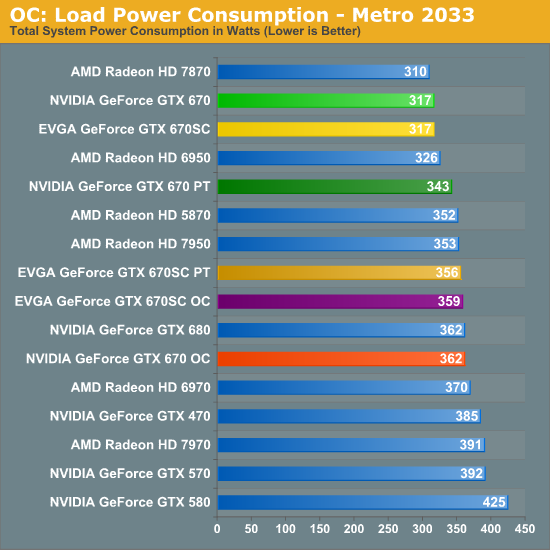
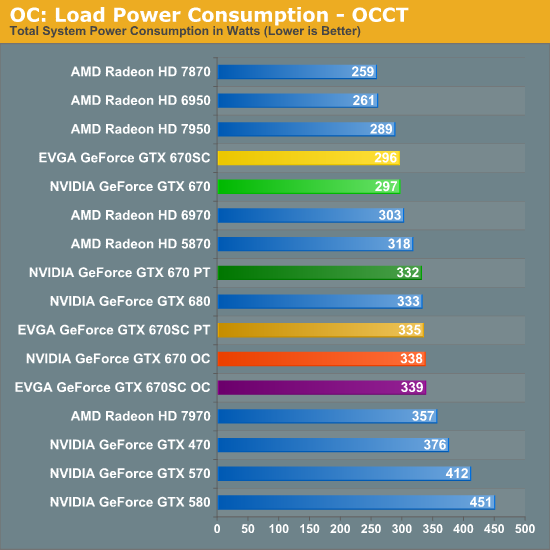
Not surprisingly, since we’re almost always operating within the realm of the power target as opposed to the TDP on the GTX 600 series, our power consumption closely follows our chosen power target. Cranking up the power target on the GTX 670 for example to 170W puts us within 6W of the GTX 680, which itself had a 170W power target in the first place. This is true for both Metro and OCCT, which means power consumption is very predictable when doing any kind of overclocking.
This also means that power consumption is still 18W-30W below the 7970, which in turn means that if these overclocks can close the performance gap, then the GTX 670 still has a power consumption advantage.
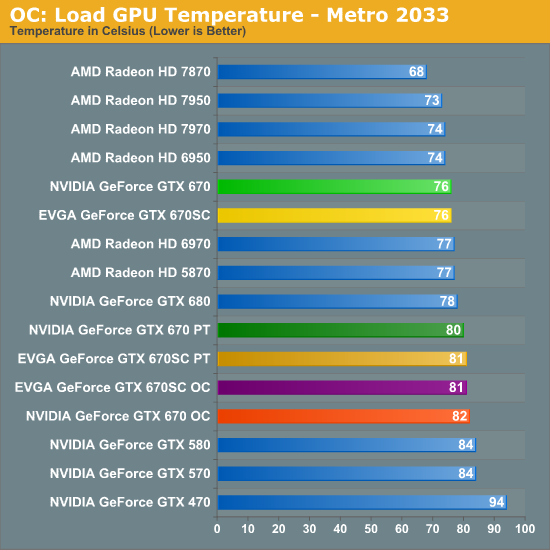
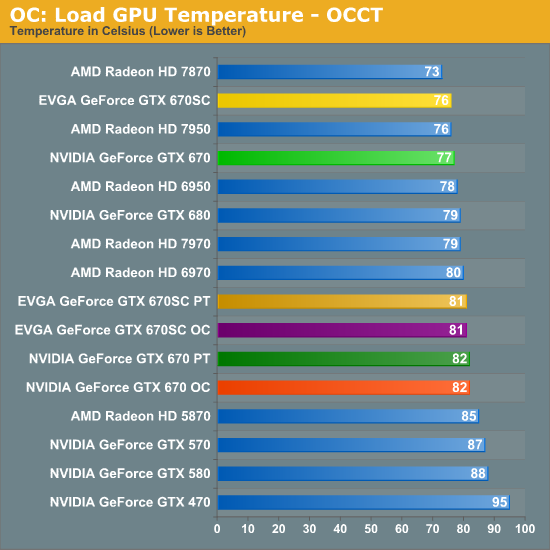
As to be expected, with an increase in power consumption comes an increase in load temperatures. However the fact that we’re only able to increase power consumption by about 30W means the temperature rise is limited to 4-5C, pushing temperatures into the low 80s. This does end up being warmer than the equivalent GTX 680 however due to the 680’s superior heatsink.
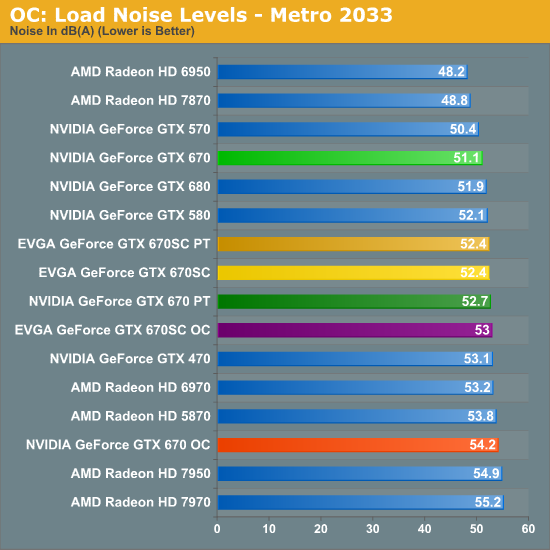

Finally, when it comes to noise we’re also seeing the expected increase, but again it’s rather small. Under Metro the amount of noise from the reference GTX 670 rises by under 3dB when pushing the power target higher on its own, while it rises 3dB when adding in our full overclock. Again the smaller cooler means that the GTX 670’s fan has to work harder here, which means our gaming performance may be able to reach the GTX 680, but our noise is going to slightly exceed it. As a point of reference, in the process we’ll also exceed the GTX 580’s noise levels under Metro. Still, in both OCCT and Metro none of our GTX 670 cards exceed the Radeon HD 7900 series, which means we've managed to increase our performance relative to those cards without breaching the level of noise they generate in the first place.










414 Comments
View All Comments
chizow - Thursday, May 10, 2012 - link
Except in this case, the "underdog" AMD initiated this pricing debacle with the terribly overpriced 7970 and the "leader" Nvidia was content to follow, selling their mid-range ASIC GK104 as a high-end SKU.While Nvidia did improve the situation with their GK104 pricing, its still by far, the worst increase we've seen from a price:performance perspective in the last decade of GPUs.
CeriseCogburn - Sunday, May 13, 2012 - link
You're in the GTX670 review, it's $399, it has come out fast, and it's awesome and beats the more epxensive flagship 7970, and destroys and historical price/perf you've got handy.Utter decimates it.
Best in years, best in a decade is now the line you should be using for the GTX670.
Crazyeyeskillah - Thursday, May 10, 2012 - link
don't buy it if you can't afford it, other people will gladly take your place in line. I'm just glad we have some next gen products from both companies to choose from. If anything we are very fortunate to have so many products available that can max out all our games at present.chizow - Thursday, May 10, 2012 - link
Its not a matter of being able to afford it, its about standards and expectations, which I'm not willing to lower for substandard offerings for products that are neither essential for survival nor expire on their own due to wear.They're high-priced toys and nothing more and there's *PLENTY* of other distractions in that endless category of entertainment to compete with, especially when these new offerings don't offer compelling reasons to upgrade over my last-gen $500 GPUs.
The other consideration is buying these parts at high premiums sets a bad precedence, where the consumer gets *LESS* for their money and similarly gives Nvidia free reign to set a new bar for premium price and performance in the future.
We've already gotten a taste of this with the GTX 690 for $1000!!! What do you think is next with GK110? Why don't you look historically at the reaction to the 8800 Ultra at $830? Nvidia is *STILL* trying to downplay that part and justify their pricing decisions, but with a mid-range ASIC like GK104 selling for $500 premium flagship prices, Nvidia is once again positioned to sell an "Ultra" part at ultra-premium pricing. For what? A part that performs as you would've expected from a $500 flagship to begin with, roughly +50% more than the last-gen flagship.....
Crazyeyeskillah - Thursday, May 10, 2012 - link
i don't buy any of that wahhhCeriseCogburn - Thursday, May 10, 2012 - link
Charlie D from semi-accurate buys it 100%, why no U ?chizow - Thursday, May 10, 2012 - link
Yeah I know, you're too busy blithely buying overpriced GPUs to understand what I'm talking about.CeriseCogburn - Friday, May 11, 2012 - link
Maybe if you provided a percentage with a simple texted chart, heck you don't need to do ten years, the doubter could gauge the level of your sourness properly - after all .01% less of a jump in performance below the worst jump in the last ten years fits all of your descriptions 100%.So why are you moaning about .01% ?
SlyNine - Thursday, May 10, 2012 - link
Well when the 7970 came out that was by far the worst. Its alot better now, but I agree this jump hasn't been one for value at all. People don't remember the great videocards I guess. The 5870 was the last one in my eyes.CeriseCogburn - Friday, May 11, 2012 - link
5870 jumped from the 4890. Now please, let's see this enormous perf increase somewhere... as compared to the current.No less than that, the 5870 was replaced by the 6870, also not so great a leap.
We keep hearing about these ephemeral perf increases, but so far NO ONE, and I mean NO ONE has provided even a simple percent increase chart - and you know why ?
Because you people love to quaff out moaning fantasies like "double performance" and says things like "the great GTX880 !" (after of course bitching for a four years it was extremely overpriced and not ever worth it).
So let's see it my friends, where pray tell is this great alluded to but never actually defined gigantic performance increase now not seen ?
4890-5870-6970 ????
Come on now, let's have one of you true believers gum up the work and give us a good percentage comparison we don't have to rip apart for immense biased game picking.
Should take one of you all but 10 minutes. Charts are everywhere.
Use the anand bench for cripes sakes, I'm sick of hearing the moanings and fantasies with no simple effort of a comonly available percentage - and you know why - because I'm calling BS !
Now - let's see it !